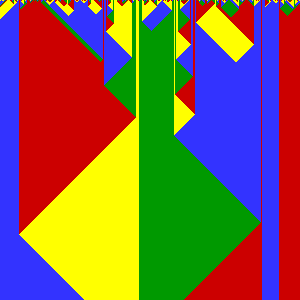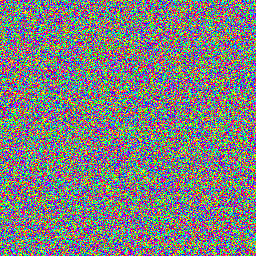A one-dimensional cyclic cellular automaton with n = 4, run for 300 steps from a random initial configuration.
A cyclic cellular automaton is a kind of cellular automaton rule developed by David Griffeath
and studied by several other cellular automaton researchers. In this
system, each cell remains unchanged until some neighboring cell has a modular
value exactly one unit larger than that of the cell itself, at which
point it copies its neighbor's value. One-dimensional cyclic cellular
automata can be interpreted as systems of interacting particles, while
cyclic cellular automata in higher dimensions exhibit complex spiraling
behavior.
Rules
As with any
cellular automaton, the cyclic cellular automaton consists of a regular
grid of cells in one or more dimensions. The cells can take on any of states, ranging from to .
The first generation starts out with random states in each of the
cells. In each subsequent generation, if a cell has a neighboring cell
whose value is the successor of the cell's value, the cell is "consumed"
and takes on the succeeding value. (Note that is the successor of ; see also modular arithmetic.) More general forms of this type of rule also include a threshold parameter, and only allow a cell to be consumed when the number of neighbors with the successor value exceeds this threshold.
One dimension
The one-dimensional cyclic cellular automaton has been extensively studied by Robert Fisch, a student of Griffeath.
Starting from a random configuration with n = 3 or n = 4,
this type of rule can produce a pattern which, when presented as a
time-space diagram, shows growing triangles of values competing for
larger regions of the grid.
The boundaries between these regions can be viewed as moving
particles which collide and interact with each other. In the three-state
cyclic cellular automaton, the boundary between regions with values i and i + 1 (mod n)
can be viewed as a particle that moves either leftwards or rightwards
depending on the ordering of the regions; when a leftward-moving
particle collides with a rightward-moving one, they annihilate each other, leaving two fewer particles in the system. This type of ballistic annihilation process occurs in several other cellular automata and related systems, including Rule 184, a cellular automaton used to model traffic flow.
In the n = 4 automaton, the same two types of particles
and the same annihilation reaction occur. Additionally, a boundary
between regions with values i and i + 2 (mod n) can
be viewed as a third type of particle, that remains stationary. A
collision between a moving and a stationary particle results in a single
moving particle moving in the opposite direction.
However, for n ≥ 5, random initial configurations tend to
stabilize quickly rather than forming any non-trivial long-range
dynamics. Griffeath has nicknamed this dichotomy between the long-range
particle dynamics of the n = 3 and n = 4 automata on the one hand, and the static behavior of the n ≥ 5 automata on the other hand, "Bob's dilemma", after Bob Fisch.
Two or more dimensions
A two-dimensional cyclic cellular automaton with n = 16, for 1300 steps starting from a random initial configuration.
In two dimensions, with no threshold and the von Neumann neighborhood or Moore neighborhood,
this cellular automaton generates three general types of patterns
sequentially, from random initial conditions on sufficiently large
grids, regardless of n.
At first, the field is purely random. As cells consume their neighbors
and get within range to be consumed by higher-ranking cells, the
automaton goes to the consuming phase, where there are blocks of color
advancing against remaining blocks of randomness. Important in further
development are objects called demons, which are cycles of adjacent
cells containing one cell of each state, in the cyclic order; these
cycles continuously rotate and generate waves that spread out in a spiral
pattern centered at the cells of the demon. The third stage, the demon
stage, is dominated by these cycles. The demons with shorter cycles
consume demons with longer cycles until, almost surely, every cell of the automaton eventually enters a repeating cycle of states, where the period of the repetition is either n or (for automata with n odd and the von Neumann neighborhood) n
+ 1. The same eventually-periodic behavior occurs also in higher
dimensions. Small structures can also be constructed with any even
period between n and 3n/2. Merging these structures, configurations can be built with a global super-polynomial period.
For larger neighborhoods, similar spiraling behavior occurs for
low thresholds, but for sufficiently high thresholds the automaton
stabilizes in the block of color stage without forming spirals. At
intermediate values of the threshold, a complex mix of color blocks and
partial spirals, called turbulence, can form.
For appropriate choices of the number of states and the size of the
neighborhood, the spiral patterns formed by this automaton can be made
to resemble those of the Belousov–Zhabotinsky reaction in chemistry, or other systems of autowaves, although other cellular automata more accurately model the excitable medium that leads to this reaction.





